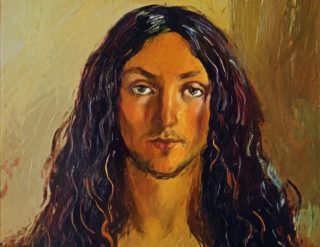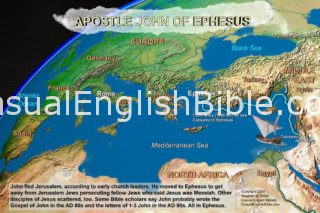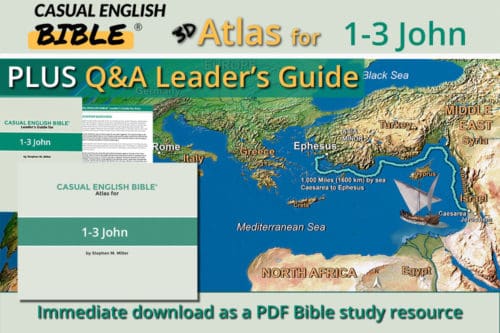These three short letters of 1, 2, and 3 John are the kind of letters you write when you don’t want to write letters.
Which could explain why they’re so short.
Clearly, there was a problem that generated those letters. But John doesn’t give the problem a name. Many scholars speculate it was a heresy later called Docetism (DOE-suh-TISS-um), though at the time it probably didn’t have a call sign other than words like “trash,” “crap,” and “hogwash,” depending on a Christian’s vocabulary and temperament.
Bible experts base their speculation on John’s unusual words of warning. Nothing like this shows up anywhere in the Bible but in the writings of John. We’ll call him John since early church leaders said he was John, the disciple of Jesus.
The warnings? John feels compelled to remind the readers of these:
- Jesus was human, not a spirit ghost. “I’ll tell you how you can recognize God’s Spirit in someone. People led by God’s Spirit will acknowledge Jesus Christ came here as a flesh-and-blood human being” (1 John 4:2).
- God the Father and Jesus the Son are one, whatever that means; John doesn’t explain it. “Anyone who rejects the Son has already rejected the Father. But anyone who believes in the Son also has the Father” (1 John 2:23). “Everyone who loves his or her Father loves his Child” (1 John 5:1).
- Believers are one with God. “Anyone who obeys God is spiritually linked to him, united. God lives in that person. God’s Spirit and the spirit of that person become one, making decisions together. We know this because the Spirit God gave us lives inside of us” (1 John 3:24).
Bible experts backward-engineer those reminders into the problems that produced them. Scholars say it’s possible people who attended the church were trying to convince others that Jesus was only a spirit-being who pretended to be human (Docetism), and we can never live up to the example he set because we’re only humans made from clay and full of dirty deeds.
When John starts his letter, he leads with that idea. Essentially, he’s saying, “Now wait a minute, my fellow apostles and I know better because ‘we’ve touched him with our hands’” (1 John 1:1).
You can’t touch a spirit, the mistaken folks apparently taught, as though they would recognize a spirit if one pinched them a good one.
The warped view of Jesus seemed to produce warped behavior. Folks apparently taught that if we believe in Jesus, it doesn’t matter what we do in this world. Go ahead and lie, cheat, and steal. We can’t help it because we’re flawed humans.
John said those ideas are spiritually lethal. He taught that people are capable of goodness because God’s Spirit lives in us.
“My dear children, I’m writing this to steer you away from sin. . . . There’s one way to tell if we really know God: We obey him” (1 John 2:1, 3).
Writer
Whether the writer is shy, humble, or afraid of getting arrested, we get no signature. We don’t know who wrote any of these three letters.
But we do get some hints.
One hint: The writer, referring to Jesus, says, “We have seen him with our own two eyes. We’ve not only looked at him but heard him and touched him with our hands” (1 John 1:1).
Since the early AD 100s, church leaders writing the first surviving documents after the New Testament said John wrote these letters. John and his brother James, along with Peter, were Jesus’s three best friends. He took them places he didn’t take the others, such as the Mount of Transfiguration, where Jesus seemed to momentarily transform into a glowing spiritual being (Matthew 17:1).
Another hint: Whoever wrote these letters wrote like the author of the Gospel of John. That’s another book early church leaders said John wrote. Both the Gospel and the letters of John, for example, call Jesus “the living Word of God” (1 John 1:1). He’s God’s message delivered in person, in the flesh.
For the sake of keeping the writing of this leader’s guide easy to read, we’ll presume the early church leaders got it right when they tagged John as the writer.
Timeline
John lived about another 60 years after Jesus left, according to early church leaders. They say he wrote 1, 2, and 3 John late in life, perhaps in the AD 80s or 90s. One clue he was an elderly man: He sometimes called church folks “my dear children” (1 John 2:1). Grownups wouldn’t likely appreciate hearing that from someone their own age.
 Location
Location
John left what is now Israel and the Palestinian Territories, early church leaders reported. He may have left because of persecution. Tradition-minded Jews banned from the synagogue fellow Jews who said Jesus was the Messiah.
That was only for starters. First-century Jewish historian Josephus (AD 37-100) reported that Jewish leaders stoned to death James, head of the Jerusalem church. He was the brother of Jesus, according to early church fathers.
John moved to Ephesus, church leaders wrote. Ephesus was a thriving city along Turkey’s west coast. Church leaders said John wrote the Gospel of John there, too, and a community of kindred souls followed his teachings and started churches throughout the region. Scholars call this group the Johannine (joe-HAN-nine) community. If you lead a Bible study, you can pronounce that if you want to sound smart. But if you want to be smart, skip it. Some info is only for your background, to load your brain in case someone asks about anything Johannian. That’s so you don’t have to answer, “Joe what?”
Destination of Letters
John’s letters sound like they target problems in a single church or perhaps in a community of churches under his guidance as a kind of bishop—though he was an apostle, the highest office during the first decades of the church.
John also writes as though he knows his readers well enough to call them his “dear friends” (1 John 2:7), “dear family” (1 John 2:12), and “dearest children” (1 John 2:18). Typically, that’s not how folks—then or now—addressed strangers.
So, John may have sent the letter to the churches under his wing in Ephesus and cities throughout what is now western Turkey.






